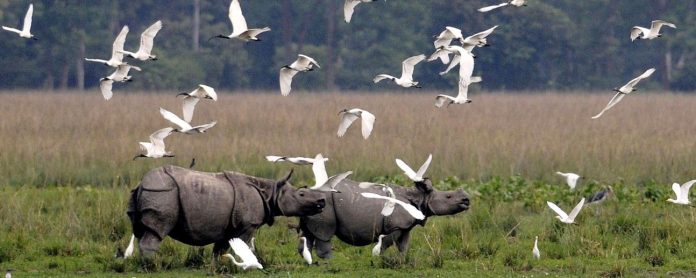By Journey Man
Almost all of India’s one-horned rhinoceros are housed in the Kaziranga National park. This is one of the most sought after wildlife holiday destinations in India. Kaziranga National Park has an area of 430 sq km and is sprinkled with elephant-grass meadows, swampy lagoons, and dense forests. It is home to more than 2,200 Indian one-horned rhinoceros, approximately 2/3rd of their total world population.
Formed in 1908 on the recommendation of Mary Curzon, the park is located on the edge of the Eastern Himalayan biodiversity hotspots – Golaghat and Nagaon district. In 1985, the park was declared as a World Heritage Site by UNESCO. It is said when Mary Curzon, the wife of the Viceroy of India – Lord Curzon of Kedleston, visited the park to see Indian one-horned rhinoceros, she wasn’t able to find even one.
Then she persuaded her husband to take urgent measures to protect the dwindling species which he did by initiating planning for their protection. After a series of meetings and documentations, the Kaziranga Proposed Reserve Forest was created with an area of 232 sq km (90 sq miles) in 1905.
Along with the iconic greater one-horned rhinoceros, the park is the breeding ground of elephants, wild water buffalo, and swamp deer. Over time, the tiger population has also increased in Kaziranga, and that’s the reason why Kaziranga was declared as a Tiger Reserve in 2006.
The park is also recognized as an Important Bird Area by BirdLife International for the conservation of avifaunal species. Birds, such as the like lesser white-fronted goose, ferruginous duck, Baer’s pochard duck and lesser adjutant, greater adjutant, black-necked stork, and Asian Openbill stork specially migrate from Central Asia during the winter season.


Undoubtedly, the park is known for its good population of animals, but more than that is the wildlife conservation initiatives that take place in the park which are more popular. With its amazing wildlife conservation activities, the park has successfully managed to grow the population of greater one-horned rhinoceros, an endangered species.
The vast expanse of tall elephant grass, marshland, and dense tropical moist broadleaf forests undoubtedly makes the park look beautiful but it’s the presence of Brahmaputra river, which makes it look enigmatic.
Declaration of Kaziranga Wildlife Sanctuary and Kaziranga National Park (1950-1974)
In 1950, the Kaziranga Game Sanctuary was again renamed as Kaziranga Wildlife Sanctuary by P. D. Stracey (the forest conservationist), so as to wipe out a name that gave hunting ideas. In 1954 the Assam government passed the Rhinoceros Bill that enforced huge penalties for hunting rhinoceros. In 1968, the government of Assam passed the Assam National Park Act of 1968, for the creation of the national park. Finally, in the year 1974, 430 sq km of the area was added and declared as Kaziranga National Park.
Kaziranga as UNESCO World Heritage Site (1985-2005)
After the declaration of national park, Kaziranga was soon declared as a UNESCO World Heritage Site in the year 1985, for its unparalleled natural environment. After such a rapid expansion, the park celebrated its 100 years with much fanfare in the year 2005, in which the descendants of Lord and Lady Curzon were invited for the celebrations. Today, Kaziranga is a World Heritage Site and is probably one of the richest, most picturesque wildlife habitats of southern Asia. In 2008, Kaziranga National park was declared as Tiger Reserve by including Laokhowa & Burachapori Wildlife sanctuaries into its congregation.
WHAT ADDS FAME TO THE KAZIRANGA NATIONAL PARK
Great Indian One-Horned Rhinoceros
The Great one horned rhino is commonly found in Nepal, Bhutan, Pakistan and in Assam, India. It is confined to the tall grasslands and forests in the foothills of the Himalayas. The Indian rhinoceros can run at speeds of up to 25 mph (40 km/h) for short periods of time and is also an excellent swimmer. It has excellent senses of hearing and smell, but relatively poor eyesight. However, no more than 2,000 remain in the wild, with only two populations containing more than 100 rhinos: Kaziranga National Park in Assam, India (1,200) and Chitwan National Park (CNP), Nepal (600). Despite joint efforts between Bhutan and India, the survival of a small population of rhinos living along the Indo-Bhutan border in Manas still remains doubtful.
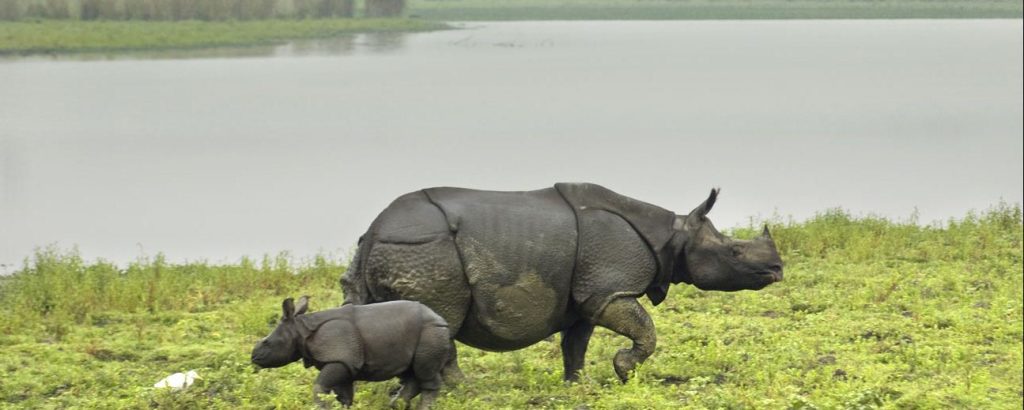

Physical appearance
Indian rhinos are brownish-gray in color and are hairless. They have knobby skin that appears to be armor-plated. A single horn sits on top of their snout, and their upper lip is semi-prehensile.
The largest of the Asian rhinos, male Indian rhinos weigh approximately 2,200 kg (nearly 4,840 pounds) and range in height from 170 to 186 cm (67 to 73 inches) and are 368 to 380 cm (145 to 150 inches) long. Their horns can grow to 45 cm (18 inches). Females are smaller, weighing only 1,600 kg (3527 pounds) and standing 148 to 173 cm (58 to 68 inches) tall. Female Indian rhinos are 310 to 340 cm (122 to 134 inches) long. A female is pregnant for 16 before giving birth.
Note: Black, Sumatran, and Javan rhino females are similar in size to the male of the species.
Elephant safari in Kaziranga
Elephant safari starts from very early morning and continues for one or 1/2 hours, elephant safari is the best way to explore the wide varieties of wildlife in the Kaziranga National Park, area covered by the elephant grass can be best viewed trip through elephant’s back. Elephant safari is best enjoyed in the early morning, during safari one can get opportunity to see herds of Indian elephants,
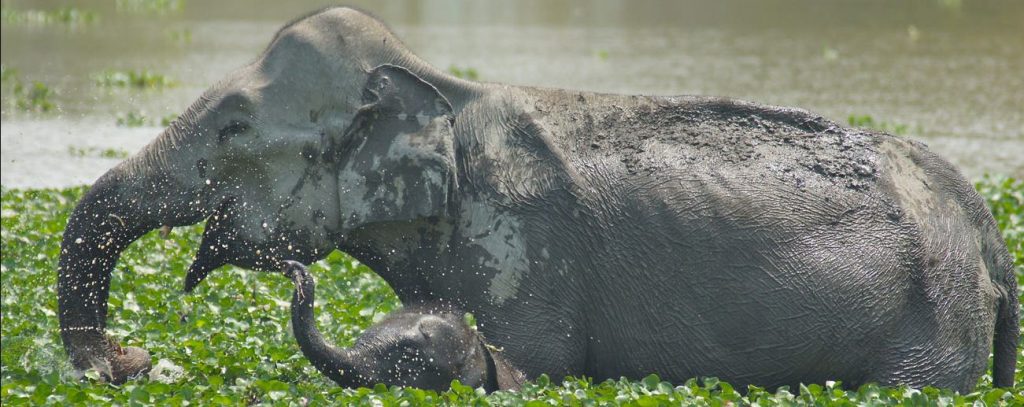

One-horned Rhinoceros very short distance, a close encounter with the animals in Kaziranga National Park makes the trip memorable. Elephant safari covers Baguri, Hole Path, Mihimukh, Kohora Central Path and Arimarah.
Flora in Kaziranga
The flora in Kaziranga National Park chiefly consist of three major types: alluvial inundated grasslands consisting of tall thickets of elephant grass and short grasses, tropical wet evergreen forests and tropical semi-evergreen forests. But, the main characteristics of flora in Kaziranga are the dense and tall elephant grass intermixed by small swamplands left behind by the receding flood waters of the river Brahmaputra.
In addition to grasses and forests, the swamps of Kaziranga National Park have an abundant cover of water lilies, water hyacinth and lotus, providing a beautiful look to the surroundings of the park. Rattan Cane, which is a type of climbing palm, also adds to the natural beauty of Kaziranga National Park.
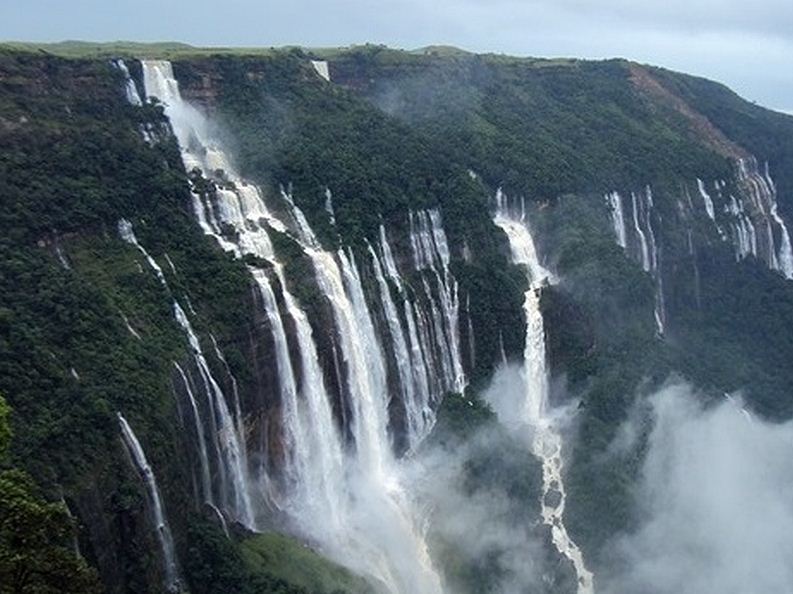

According to a Landsat data for 1986, the different vegetation coverage in Kaziranga National Park is as follows: Tall thickets of elephant grasses 41%, short grasses 11%, open jungle 29%, rivers and water bodies 8%, sand 6% and swamps 4%.
Due to the difference in altitude between the eastern and western areas of the park, here one can see mainly four types of vegetation like alluvial inundated grasslands, alluvial savanna woodlands, tropical moist mixed deciduous forests, and tropical semi-evergreen forests. Kumbhi, Indian gooseberry, the cotton tree, and elephant Apple are amongst the famous trees that can be seen in the park. Also, a good variety of aquatic flora can be seen in lakes, ponds, and along the river shores.
Fauna
The forest region of Kaziranga Park is home to the world’s largest population of Indian rhinoceros. Other animals that can be seen in the elephant grass, marshland and dense tropical moist broadleaf forests of Kaziranga are hoolock gibbon, tiger, leopard, indian elephant, sloth bear, wild water buffalo, swamp deer, etc.
Best Time to Visit
Kaziranga Park remains closed from May 1 till October 31 every year for the visitors. Therefore November to April is the best time to visit Kaziranga National Park.
Summer (April to May): During this time of the year, the climate remains dry and windy; one can find animals around the water bodies.
Monsoon (June to September): From June till September, the region receives heavy rain, approximately 2,220 millimeters (87 in); thus the climate remains hot and humid. The park remains closed from May to October due to warnings of Brahmaputra river floods.
Winter (November to February): Perhaps the best time to visit the Kaziranga National Park as the climate is mild and dry. Chances of spotting rhinos are more in winter as the grass burn off and the background becomes clearer.
SAFARI TIMINGS
To promote wildlife tourism in Assam, Kaziranga Park authorities organizes a jeep and elephant safari tour.
Morning Jeep Safari: 8:00 AM to 10:00 AM
Afternoon Jeep Safari: 02:00 PM to 04:00 PM
Elephant Safari Timing
Morning: 05:30 / 06:30
Morning: 06:30 / 07:30
Safari Gate/Zones
Sprawling over an area of 430 sq km, the park alias the hotspot of diversity is split into four areas; each has its own distinguishing feature regarding grasslands, the density of mammals & birds, land topography, and terrains. Below are some points of the pre-defined tourist circuits where the jeep safari takes place:
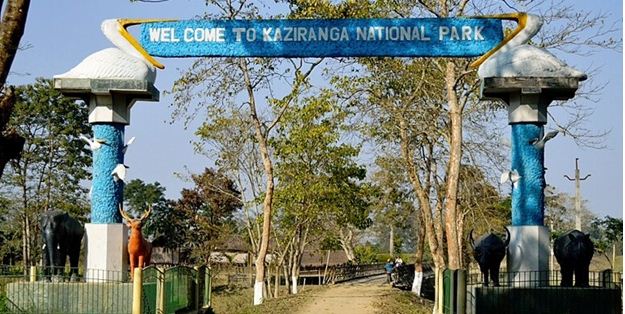

Major Attractions in & Around the Park
To enjoy the best of the park, it would be good to take a jeep or elephant, but what apart from these options? Fortunately around Kaziranga, one can find an ample number of nature getaways options like wildlife sanctuaries, parks for bird watching and hill stations. So, if, by chance, tourists have some extra days at their disposal then go to the list of places mentioned below to make the holiday even more memorable. Below are some places to visit around Kaziranga National Park.
Wildlife in Kaziranga National Park
A moderate climate combined with the availability of enough food resources supports the growth and survival of a unique and diverse wildlife in Kaziranga National Park. Apart from being a rich natural habitat for the great Indian One-horned Rhinos, Kaziranga Wildlife Sanctuary also has a sizable population of the Wild Buffalos and Indian Elephants. Herds of wild elephants, sometimes numbering up to 200, can be seen migrating from the Mikir hills to the bheels (marshes or ox-bow lakes), offering the most spectacular view to the wildlife enthusiasts.
Kaziranga National Park also shelters about 15 species of India’s threatened mammals. Apart from the above mentioned three, other most notable wildlife of Kaziranga National Park also includes: about 15 species of India’s threatened mammals.
Mammals
One horned rhinoceros (rhinoceros unicornis), wild buffalo (bubalus bubalis), indian elephant (elephas maximus), royal bengal tiger (panthera tigris), Indian wild boar (sus scrofa), eastern mole (talpa micrura), pangolin (manis crassicaudata), indian gaur (bos gaurus), swamp deer (cervus duvauceli), sambar (cervus unicolor), barking deer (muntiacus muntjak), white browed gibbon (hylobates hoolock), hog deer (axis porcinus), capped langur or leaf monkey (presbytis pileatus), rhesus macaque (macaca mulatto), assamese macaque (macaca assamensis), leopard (panthera pardus), sloth bear (melursus ursinus), indian porcupine (hystrix indica), fishing cat (felis viverrina), jungle cat (felis chaus), large indian civet (viverra zibetha), small indian civet (viverricula indica), indian gray mongoose (herpestes edwardsi), small indian mongoose (herpestus auropunctatus), bengal fox (vulpes bengalensis), golden jackal (canis aureus), common otter (lutra lutra), chinese ferret badger (melogale moschata), hog badger(arctonyx collaris), ganges and indus river dolphin (platanista gangetica), orange-bellied himalayan squirrel (dremomys lokriah), asiatic black bear (selenarctos thibetanus).
Snakes
Black krait (bungarus niger), bengal cobra (naja kaouthia), banded krait (bungarus fasciatus), common kukri snake (oligodon arnensis), checkered keelback watersnake (amphiesma stolata), common or long-nosed vine snake (ahaetulla nasuta), copperhead trinket snake (elaphe radiata), common krait (bungarus caeruleus), king cobra (ophiophagus hannah), pit vipers (trimeresurus spp.), rock python (python molurus), russell’s viper (vipera russellii), reticulated python (python reticulatus), rat snake (ptyas mucosus), striped keelback (amphiesma stolata).


Lizards
Assam greyish-brown gecko (hemidactylus garnotii), assam olive-brown skink (mabuya multifasciata), assam greyish-brown gecko (hemidactylus garnotii), common bengal monitor (varanus bengalensis), common indian skink (mabuya carinata), dotted garden skink (lygosoma punctata), indian water monitor (varanus salvator), light-olive assam garden lizard (calotes emma), ticticky house gecko (hemidactylus frenatus), tuckto gecko (gecko gecko).
Turtles and tortoises
Assam roofed turtle (kachuga sylhetensis), brown roofed turtle (kachuga smithii), brown hill tortoise (manouria emys), gangetic or indian softshell turtle (aspideretes gangeticus), indian roofed turtle (kachuga tecta), indian tent turtle (kachuga tentoria), indian eyed turtle (morena petersi), indian peacock softshell turtle (aspideretes hurum), indian flapshell turtle (lissemys punctata), indian black turtle (melanochelys trijuga), keeled box turtle (pyxidea mouhotii), malayan box turtle (cuora amboinensis), narrow headed softshell turtle (chitra indica), spotted pond turtle (geoclemys hamiltonii), oldham’s leaf turtle (cyclemys oldhami).
Crocodiles – gharial (Gavialis gangeticus) :
Fishes like Anabas testudineus, amblypharyngodon mola, amphipnous cuchia, bagarius bagarius, xenentodon cancila, catla catla, chanda nama, channa amphibia, channa orientalis, channa marulius, channa punctata, channa striatus, cirrhina mrigala, clarius batrachus, colisa lalius, colisa fasciata, eutropiichthys vacha, gudiusia chapra, glossogobius giuris, heteropneustes fossilis, labeo bata, labeo calbasu, labeo rohita, labeo nandina, labeo gonius, mastacembelus armatus, mystus bleekeri, mystus cavasius, mystus menoda, aorichthys seenghala, mystus vittatus, nandus nandus, notopterus chitala, notopterus notopterus, ompak pabo, salmostoma bacaila, puntius ticto, puntius sarana, rasbora daniconius, rasbora elenga, tetraodon cutcutia, wallago attu.
How to Reach Kaziranga National Park
By Air : Jorhat Airport, 96 KM from Kaziranga National Park, is the closest airport. Else tourists can also deplane at Tezpur Airport, 59.9 KM from the Kaziranga National Park.
By Rail : Furkating Junction railway station, hardly a two-hour drive from Kaziranga National Park, is the nearest railway station.
By Road : To travel by road, firstly go to Jorhat or Guwahati (240 km) and then take a cab or a bus to reach the park.
History of Kaziranga National Park
Turned up in the Golaghat and Nagaon districts of the state of Assam, Kaziranga National Park dates back to the early 20th century, when an American lady ‘Baroness Mary Victoria Leiter Curzon’, who was the wife of Lord Curzon (the Viceroy of India), visited Kaziranga in the year 1904.
During that period, Kaziranga had been far-famed for its huge population of rhinoceros, but during her trip in the region, she failed to see any rhinoceros in the forest. Only hoof marks were observed. Well, it was bruited that Balaram Hazarika, the famous Assamese animal tracker showed Baroness Curzon and told her about the urgent requirement for wildlife conservation. Then, she asked her husband to take the action for the preservation of a rhinoceros, which her husband did on November 4, 1904 whilst he suggested creating a reserve in Kaziranga. Later on, formal documents of that proposal for the formation of the Kaziranga Reserve Forest dated in September, 1905. Therefore, on June 1, 1905, the Kaziranga Proposed Reserve Forest was made with an area of 232 km2 (90 sq mi).
HOTELS & RESORTS IN KAZIRANGA
Jupuri Ghar, Kaziranga, Starting price @2599
Jupuri Garh, is situated just off to the main road, in the Kohora Tourist range, opposite to the Central Zone entrance within an easy access to the booking office. The resort is surrounded by woodland at the foot of a hill and close to the Kaziranga National Park, local tea estates and the Mikir Hills. The village town will be within a 10 minute walk. The accommodation in Zupuri Garh is standard but very clean and the whole property is set out in beautifully landscaped and maintained gardens.
Facilities
The facilities at Jupuri Ghar consist of the arrangements of Jeep Safari, Elephant safari, bon fire, village visits, tea garden visit and airport / railway station pick up.
Wild Grass Lodge, Starting price @3099
The Wild Grass Lodge is a jungle lodge located outside of kaziranga national park, 200 kms from guwahati, Assam. It is built in an attractive rural style kind of architecture, with grounds having more than 40 species of trees over 200 species of shrubs, creepers and climbers. You will feel the perfect harmony of nature.
(Note: The above are all indicative. Travelers are advised to find more on their own before booking).

